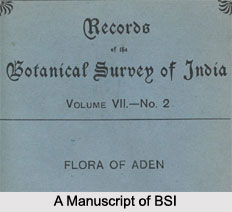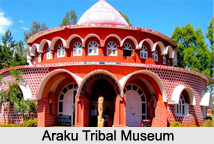 The Botanical Survey of India (BSI) is the apex research organization under the MOEF for carrying out taxonomic and floristic studies on wild plant resources of the country.
The Botanical Survey of India (BSI) is the apex research organization under the MOEF for carrying out taxonomic and floristic studies on wild plant resources of the country.
History of Botanical Survey of India
BSI was established on 13th February, 1890 with the basic objective to explore the plant resources of the country and to identify the plants species with economic virtues.
Sir George King, the then Superintendent of the "Royal Botanic Garden" Calcutta was appointed as First ex-officio Honorary Director of the BSI. After independence, the department was reorganized in 1954 by Government of India as a part of scientific development of the country. Its functional base was further expanded to include various new areas.
Objectives of Botanical Survey of India
During the successive five year plan periods, the functions of Botanical Survey of India were further diversified to include various new areas such as assessment and inventorisation of endemic, rare and threatened plant species; evolving conservation strategies; studies on fragile ecosystems and protected areas like Sanctuaries, National Parks and Biosphere Reserves; monitoring of changes in floristic components; ex-situ conservation, multiplication and maintenance of germplasm of plant genetic resources, endemic and threatened species, wild ornamentals, etc.; ethnobotanical and geobotanical studies and the development of National Database on Herbarium (including Type specimens) live collections, plant genetic resources, plant distribution and nomenclature. The aims and objective of the department were redefined, reviewed during the year 1987 and survey and exploration of plant resources and inventorisation of threatened species, publication of National and State Floras and development of National database were given top priority.
Activities of Botanical Survey of India
The Botanical Survey of India (BSI) is the apex research organization under the Ministry of Environment and Forests, Govt. of India for carrying out taxonomic and floristic studies on wild plant resources of the country. It was established on 13th February, 1890 with the basic objective to explore the plant resources of the country and to identify the plants species with economic virtues. The Botanical Survey of India has the nine regional circles situated at different regions of the country. The following are the primary activities being carried out by the BSI:
•Exploration, inventorying and documentation of phyto-diversity in general and protected areas, hotspots and fragile ecosystems in particular; publication of National, State and District Floras.
•Identification of threatened/red list species and species rich areas needing conservation; ex-situ conservation of critically threatened species in botanical gardens.
•Survey and documentation of traditional knowledge (ethno-botany) associated with plants.
•Develop a National database of Indian plants, including herbarium and live specimens, botanical paintings/illustrations, etc.
The secondary activities carried out by BSI are:
•Revisionary/Monographic studies on selected plant groups.
•Qualitative analysis of nutritive value of ethno-food plants and other economically useful species.
•Capacity building in plant taxonomy through refresher courses and post M.Sc. certificate course.
•Environment Impact Assessment of areas assigned by the ministry.
•Develop and maintain Botanical Gardens, Museums and Herbaria.
•Preparation of Seed, Pollen and Spore Atlas of Indian Plants.
Herbarium at Botanical Survey of India
 Through a series of about 250 intensive and extensive exploration, covering about 80% of the angiosperm plant wealth of the Islands, a herbarium with internationally recognized acronym PBL has been established. It has 33,000 dried, mounted and preserved plant specimens collected from different parts of A & N Islands and that of South-East Asian Countries. In this Herbarium about 140 families of flowering plants are represented. It comprises a significant number of rare specimens collected by some of the pioneer plant collectors viz., Col. Robert Kyd (1791). J.W.Helfer (1839), W.S. Kurz (1866), David Prain (1889) and Sir George King (1890). The recent collections, especially of N.P. Balakrishnan, T.A. Rao, M. K. V. Rao, K. Thothathri, N. G. Nair, N. Bhargava, B. K. Sinha, P. Lakshminarsimhan, S. K. Srivastava & P.S.N.Rao, P.V Sreekumar, R.P. Pandey, S. Kumar, C. Murugan, K. P. Rajesh, M.Y.Kamble, Jagadeesh Ram, L.J. Singh, etc have further enriched the herbarium. The herbarium also holds 97 type specimens of new taxa discovered since the inception of this Regional Centre.
Through a series of about 250 intensive and extensive exploration, covering about 80% of the angiosperm plant wealth of the Islands, a herbarium with internationally recognized acronym PBL has been established. It has 33,000 dried, mounted and preserved plant specimens collected from different parts of A & N Islands and that of South-East Asian Countries. In this Herbarium about 140 families of flowering plants are represented. It comprises a significant number of rare specimens collected by some of the pioneer plant collectors viz., Col. Robert Kyd (1791). J.W.Helfer (1839), W.S. Kurz (1866), David Prain (1889) and Sir George King (1890). The recent collections, especially of N.P. Balakrishnan, T.A. Rao, M. K. V. Rao, K. Thothathri, N. G. Nair, N. Bhargava, B. K. Sinha, P. Lakshminarsimhan, S. K. Srivastava & P.S.N.Rao, P.V Sreekumar, R.P. Pandey, S. Kumar, C. Murugan, K. P. Rajesh, M.Y.Kamble, Jagadeesh Ram, L.J. Singh, etc have further enriched the herbarium. The herbarium also holds 97 type specimens of new taxa discovered since the inception of this Regional Centre.
Museum of Botanical Survey of India
More than 400 exhibits including pickled specimens of Carpological collections, medicinal plants, rare orchids, ethno-botanical collections, sea-grasses, sea weeds and botanically important specimens have been displayed. Apart from this, several laminated colour photographs depicting endemic species and vegetation pattern of the Islands have been displayed in the Museum.
Library at Botanical Survey of India
At present the library has about 5000 classical books dealing with different aspects of floristic, plant taxonomy, ethno botany, phyto geography and environmental sciences and many of the source data books like Index Kewensis, Pflanzenreich, De Candolle"s Prodromus, and sets of Indian as well as foreign journals like Kew Bulletin, Blumea, Garden"s Bulleting Singapore, etc. In addition, general reference books like Encyclopedia Britannica, Flora Malesiana, Wealth of India, etc. are also present. The Library is currently subscribing 20 foreign and 30 Indian journals. This is the only Library in the A & N Islands that supports research in systematic Botany and allied fields. This library also has some Hindi books.
Online Platform of Botanical Survey of India
The Botanical Survey of India (BSI) has developed the first open-access online database of India`s floral diversity to document over 18,000 flowering plant species in an effort at boosting digitisation and conservation of endangered ones. The `eFlora India` test site was launched by BSI in July 2015, on the occasion of the `Digital India Week`. The portal, once formally launched, will also serve as an updated plant checklist of India.













